US Space Force Advances in Space Operations with X-37B Mission
The United States Space Force is making significant strides in its mission to enhance space capabilities through innovative technology, as demonstrated during the recent flight of the X-37B spaceplane. Officials have highlighted that this mission tested "space domain awareness technology experiments," aimed at bolstering the Space Force’s understanding of the evolving space environment—a domain that military leaders now consider akin to other contested areas such as land, sea, and air.
Key Developments from the X-37B Mission
The recent X-37B mission succeeded in testing various technologies pertinent to operational readiness in space. Among the highlights was the demonstration of aerobraking maneuvers, which could have future applications in operational military satellites. General Stephen Whiting, the head of US Space Command, emphasized the importance of these tests, stating, "The X-37 is a test and experimentation platform… that aerobraking maneuver allowed it to bridge multiple orbital regimes, and we think this is exactly the kind of maneuverability we’d like to see in future systems."
The development and refinement of such technologies are viewed as critical in creating new operational concepts essential for securing and defending American interests in space.
Broader Context and Implications
The Space Force’s current operations come at a time of increasing competition in space, particularly from nations like China, which have advanced capabilities including on-orbit refueling. This capability allows adversaries to remain more flexible and maneuverable in space, underscoring the need for the United States to enhance its own situational awareness and readiness in the space domain.
Gen. Whiting noted the significance of maneuvering within this domain, stating, “An irony of the space domain is that everything in our AOR is in motion, but rarely do we use maneuver as a way to gain positional advantage.” This acknowledgment points to a shift that may be necessary for effective space strategy moving forward—adapting concepts traditionally employed by military branches such as the Army, Navy, and Air Force.
Future Directions for Space Operations
The Space Force has not yet announced the details of its next X-37B launch, though it has been customary for missions to take place within a year of the previous flight’s conclusion. Since the X-37B’s inaugural mission in 2010, every flight has launched from Florida, demonstrating a consistent operational pattern as the aircraft undergoes refurbishment at NASA’s Kennedy Space Center.
Moving forward, Space Command is exploring several avenues to improve maneuverability in space, including in-orbit refueling and alternative propulsion methods like solar-electric propulsion. These developments could open up a range of strategic options for space operations, enhancing capabilities for surveillance, defense, and potential combat scenarios involving adversary satellites.
Conclusion: The Path Ahead for US Space Operations
The advancements showcased by the X-37B mission showcase the Space Force’s commitment to exploring and implementing new technologies to ensure dominance in the emerging battlefield of space. As nations around the globe accelerate their space programs, understanding the dynamics at play and developing robust strategies for maneuverability and operational advantage become paramount.
The successful testing of the X-37B indicates that the U.S. is not only committed to strengthening its own space capabilities but is also cognizant of the need for adaptability in a rapidly changing strategic environment. As space becomes increasingly contested, the implications for military operations, national security, and international relations will be significant, establishing a new frontier in defense strategy.









